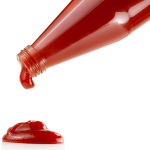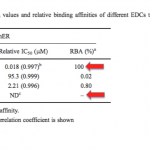It's nearly impossible to get every last drop of liquid foods out of their containers. Ketchup and syrup are among the worst offenders. Up to 15 percent can be wasted due to such inefficient packaging. But a team of engineers, mostly from Colorado State University, has devised a solution to the world's sticky container problem using a super-hydrophobic material.
Chemicals & Chemistry
We've been calling for a ban on triclosan — the antibacterial chemical in hand soap — for some time. The FDA has finally done the right thing, because the soaps are worthless and possibly harmful. But the agency has taken action for the wrong reason, at least partly. Here's why.
When ACSH's Alex Berezow was the editor of RealClearScience, he frequently linked to Pacific Standard's content. However, in recent months, he says the magazine as a whole has now become nearly unreadable. As its political cheerleading becomes more and more blatant, its standards for science journalism have fallen -- and that's no coincidence.
Organic farming produces 20% fewer crops. An inefficient food production system is, by definition, not sustainable. The authors also underscore this point by noting that “if all US wheat production were grown organically, an additional 12.4 million hectares (30.6 million acres) would be needed to match 2014 production levels.” Extrapolate that out to the rest of the globe, and one can easily see how organic farming cannot feed the world.
Plastic food wraps are pretty much ubiquitous in today's markets. But they have drawbacks — they aren't biodegradable, and don't keep foods as fresh as they might. Scientist from the USDA have come up with a new type of wrap — it's biodegradable, keeps foods fresher, and it's edible to boot.
Honey bees are at record numbers; wild bees are fine. So why are activists still promoting a Zombie Beepocalypse? ACSH Scientific Advisor Prof. Allen Felsot settles the matter.
California’s Safe Drinking Water and Toxic Enforcement Act, commonly called Proposition 65, was enacted by popular vote in 1986. It was initially sold as a way to prevent cancer and birth defects due to chemicals in drinking water and therefore got an overwhelmingly favorable response. Who isn’t in favor of clean water? (1)
Yet unmentioned by most at that time was that the voter referendum turned California science over to political appointees, who have final authority to make decisions on warning labels. In the last 30 years, despite a lot of strange listings and too many nuisance lawsuits to count, few decisions have been as bizarre as their desire to label BPA as a health hazard even though every national science organization has shown otherwise.
The presence of a molecule that strongly enhances the flavor of other molecules may explain why garlic powder is such a commonly used ingredient in cooked foods.
Bottled water and other drinks typically come in plastic bottles made from PET. If not recycled, PET bottles stick around forever. But, some really clever microbiologists found a bug that evolved solely to eat the bottles. Will this be useful?
There are not many chemistry labs that begin their experiments by first baking fresh bread. Yet, that is exactly what a lab in China does in its pursuit of cheap and effective carbon foam. This porous, light-weight material could be useful in aerospace engineering or as a building insulator.
Organic food companies, environmental groups and fame-seeking celebrities have been attempting to undermine the American public’s confidence in science by using a clever technique – telling people to fear what they cannot pronounce.
This publication breaks down how benign terminology is being manipulated in such a way as to create fear and panic about common household products and ingredients. Groups promoting "chemophobia" literally seek to use the language of science against science, to scare donors into giving them money, and to promote a dishonest agenda.
This book instead provides you with a way to separate science fact from environmental fiction.
The language of science has been hijacked. Those who are looking to make a quick buck (or in the case of the organic industry, 43 billion bucks) have no qualms about twisting the definition of highly precise scientific terminology to suit their own profit-driven agendas. Here's a brief glossary of the some of the most commonly misused scientific terms. (Note: the health food and fad diet industries are among the biggest abusers.)




